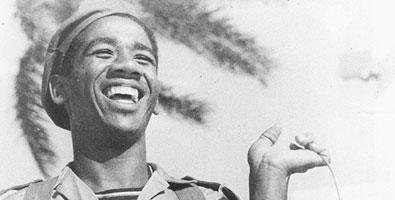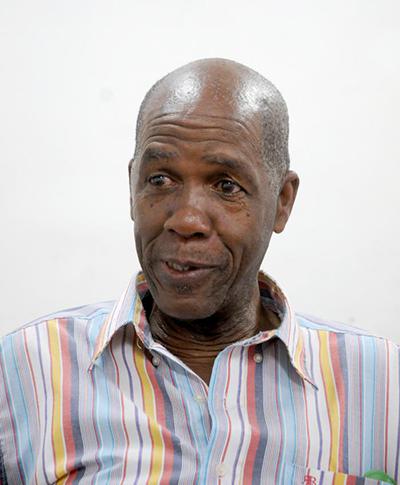
Puerto Rico ’66 multi-medal winner. National and World Youth In-door Games competitor throughout the 1960s. Central American and Caribbean, Pan American and Olympic Games 110 meters hurdles and 4 x 100m relay medal winner from 1966-1977. Multi-national record holder.
Although it might seem like the only thing to discuss with Juan Morales Hechavarría would be his outstanding sporting career during the early years of the Revolution, today GI speaks to this legend of Cuban sports, about his participation in the National Literacy Campaign 55 years ago, and how it impacted his subsequent development as an athlete.
Why did you decided to join the literacy campaign?
When we signed up to participate in the literacy campaign, I had no political consciousness. The 21 day course I took in Varadero, to then go off and teach people to read and write was fundamental. This was one of the main reasons why I joined the Literacy Campaign.
I wanted to be like my sixth grade teacher Julio. To be an important teacher, I wanted to be like him. At 12 or 13 years old, who doesn’t like to play the teacher?
Later I found out more about the campaign in the town of Soledad de Mayarí Arriba where I was sent to teach. There, we realized the importance of what we were going to do, we saw the life of campesinos, the miserable conditions in which they lived, how they lived.
However bad we were living in the cities, there was an abysmal difference between how campesinos and poor people in the city lived. Add to this the charisma of campesinos, their discipline and friendly nature.
How old were you when you went to teach people to read and write in Soledad de Mayarí Arriba?
13 years old.
What did your parents say when you, at 13 years of age, told them you were going to teach people to read and write?
We were given a permission form that our parents had to sign.
I went up to my mother and told her that I was going with my teacher to Varadero to take the literacy course and then go off to teach campesinos to read and write. At that time teacher’s word was like the law. My mother told me that she couldn’t say anything until my father got home. I waited for him and when I saw him coming I ran and told him that mom said it was OK, but that he had to sign the form because they were waiting for me. I left for Varadero and later I wound up in Soledad de Mayarí Arriba.
How many people did you teach to read and write?
Were they all adults?
There wasn’t any problem with you being so young?

No. I also worked with Haitians. Myself and one of my friends would go to the Haitians’ quarters. During the evenings I would pass by the campesino’s house and give classes.
How did you feel when you saw they were learning to read and write?
At that time one always likes to teach in school, be an outstanding Math student and be able to explain problems to other students help them understand so they would get good grades in the exams. I felt really happy. I liked it when they would tell me, ‘Now I know how to write my name.’ It was very inspiring.
What I can say is that for me, the Literacy Campaign marked the beginning of the rest of my life. Today we talk about values, and I think it was there with the campesinos where I learned the most values.
Tell us about December 22, 1961, when Cuba was declared a territory free of illiteracy in the Plaza de la Revolución…
When the campaign ended we all came to Havana. I was already talking about studying Sugar Cane Engineering, because my father worked in the San Germán mill. My father made sacrifices in order for me to go to school; he worked hard to buy me my notebooks. I came here to study and earn a degree.
I attended the Lafayette School and studied hard, but I also liked sports. Then I moved to the Tarará facility. I joined the choir but didn’t make the cut and continued with sports.
In 1965 I attended some inter-provincial games, followed by some inter-school competitions where I won first place. I was given the chance to go to a provincial competition, and I won there as well. I went to nationals and after that I was selected to take a 45 day course in Minsk (Belarus).
Why sports?
When I got back the first national games were taking place. I took part and defeated the then national champion Lázaro Betancourt and became the new national champion.
What events did you compete in?
The 110 meters hurdles. That was in 1965. That year I met the then Minister of Education José Llanusa Gobel at my school. I always liked sports, but it wasn’t the only thing I dedicated myself to, I also had other responsibilities. I had to do well in my studies to be able to go home with a qualification. My parents didn’t understand this running thing, they thought it was just a game.
Llanusa began telling me about sports in Cuba, what was going on at that moment in the country, and he told us that sports would give us the opportunity to show the achievements of the Cuban Revolution to the world, hear the national anthem played out loud and see the single star flag raised in every competition. This made an impression on me, the idea of what an athlete could do for the Revolution.
Then came the 1966 Olympic Games in Puerto Rico. I was 16 years old at the time. The athletes were selected and I was chosen among the group. That’s when the famous Cerro Pelado declaration was made. Then we left for the airport. Fidel was there, he met with us.
This was my first international competition. I competed in the 110 meters hurdles and won bronze, as well as the 4 x 100m relay where I won silver.
What other sporting events did you participate in?
After Puerto Rico I continued training for the 1967 Pan American Games in Winnipeg, Canada. There I competed in the 110 meters hurdles. It was quite a hard competition, but I was able to break the national record, set a world juvenile record and win a bronze medal.
That was my second international competition. I also competed in the 4 x 100m relay and we won a silver medal.
More success was to follow. I participated in international competitions, and often won and was in a good competitive position. In 1968, we started preparing for the Olympic Games in Mexico. I was scheduled to participate in the 110 meters hurdles and 4 X 100m relay. I set a national record and finished ninth in the 110 meters hurdles. We set three national records in the 4 X 100m relay and won the silver medal. We were only hundredths of a second behind the U.S. team.
Tell us about the events you participated in and where Fidel was present, above all during the early years of the Revolution.
Fidel was often present at many events. It was always very pleasant with him. He never put himself above others. He was very willing to talk. He would always talk about what was happening, what we were doing in sports.
Fidel was the best, in my opinion, he had an extraordinary memory; he would remember everything.
Final thoughts…
What Llanusa once told us, about how an athlete could support the Revolution – how we could hear the national anthem played out loud and see the single star flag raised – I think I fulfilled this goal. Every time I went to an international competition, I returned with a medal. I came back with a medal, heard the notes of the national anthem ring out and saw the single star flag raised. I think that through sports, I fulfilled the objective I was given.
CUBAN LITERACY CAMPAIGN
Some 707,000 people learned to read and write through the national Literacy Campaign in Cuba. Such an accomplishment has seen the country ranked among the top nations with the highest literacy rates in the world. This extraordinary revolutionary achievement was undertaken by a powerful army of at total of 271,000 educators including over 121,000 adult literacy workers; 100,000 brigadiers from the Conrado Benítez contingent; 15,000 from the Patria o Muerte division; 35,000 volunteer teachers, which in addition to the political and leadership cadres as well as administrative workers saw a total of over 300,000 participants in the Campaign (Ecured).















